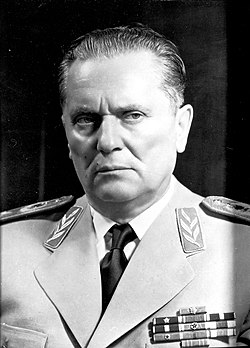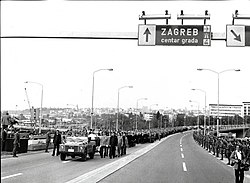Josip Broz Tito
Josip Broz Tito | |
|---|---|
 Josip Broz Tito | |
| 2ndPresident of the Socialist Federative Republic of Yugoslavia | |
| In office January 14, 1953 – May 4, 1980 | |
| Preceded by | Ivan Ribar |
| Succeeded by | Lazar Koliševski |
| 1stPrime Minister of the Socialist Federal Republic of Yugoslavia | |
| In office November 29, 1945 – January 14, 1953 | |
| Succeeded by | Petar Stambolić |
| 1stSecretary General of Non-Aligned Movement | |
| In office September 1, 1961 – October 10, 1964 | |
| Succeeded by | Gamal Abdel Nasser |
| Personal details | |
| Born | May 7, 1892 Kumrovec,Croatia,Austria-Hungary |
| Died | May 4, 1980(aged 87) Ljubljana,Slovenia,Yugoslavia |
| Political party | League of Communists of Yugoslavia |
| Spouse(s) | Pelagija Broz(married and divorced) Jovanka Broz(married) |
Josip Broz,nicknamedTito,(May 7, 1892 – May 4, 1980) was a Yugoslavcommunistrevolutionary,World War II Hero, statesman and dictator who was the leader of theSocialist Federal Republic of Yugoslavia,from 1945 until his death in 1980.[1][2]From 1945 to 1953 he was Prime Minister, and from 1953 to 1980 he was the President.His funeralon May 4, 1980, was attended by representatives of 128 out of 154 UN member countries.[3]Tito was a controversial person, with people having strong and differing views about his leadership. He has been described by some critics as anauthoritarianand abenevolent dictator.
Early life[change|change source]
Tito was born in Komrovec,Croatia,where his parents had a small farm.[4]He went to the villageelementary schooluntil 1905. In 1907 he was machinist's apprentice inSisak.In 1910 he joined the union of workers and social-democratic party of Croatia andSlavonia.In 1913 he entered theAustro–Hungarian Armyand later was imprisoned for anti-warpropaganda.DuringWorld War Ihe was wounded, captured, then imprisoned byRussians.[4]After being set free, he became active in thebolshevikmovement. After theOctober Revolution,he joined theRed Guards (Russia).In 1920 Tito came back to the new nation Yugoslavia and joined the Communist party. This was later renamedYugoslav Communist Leaguein 1952. Tito (Babo) was the leader of the Communist party from 1937 until his death. In 1921 the Yugoslav communist party was banned. Tito was imprisoned from 1928 until 1933 for being a communist.[4]In 1934 he went back toSoviet Unionand he was involved as secret agent inNKVD.
Military chief[change|change source]
In 1937 Tito came back to Yugoslavia. During theAxisinvasion of Yugoslavia inWorld War II,a civil war erupted between the collaborationists of Axis occupators (Ustaše,Croatian Home Guard,Slovene Home Guard,Serbian State Guards), royalistYugoslav Army in the Fatherlandwho wanted to bring back the monarchy, and the self-organized guerilla force ofYugoslav Partisans.Tito had the leading role in organizing theYugoslav People's Liberation Armyand liberating Yugoslavia. Their struggles were recognized by theAllies of World War IIas the true liberators of Yugoslavia. In 1945, Tito ordered the end of theKingdom of Yugoslaviaand created theSocialist Federal Republic of Yugoslaviawith six republics: Bosnia-Herzegovina, Croatia, Macedonia, Montenegro, Serbia and Slovenia, and two autonomous provinces in Serbia:Vojvodinain the north, andKosovoin the south, next toAlbania.
Presidency[change|change source]
Tito, under various positions, ruled Yugoslavia from 1945 to 1980. To be safe from assassination attempts, he was dramatically supported by the spy ringOZNAand political policeUDBA.Following theTito-Stalin splitin 1948, Yugoslavia heavily opposed the influence ofSoviet Union.His rule supressed all non-Titoist parties from forming, includingnationalist,monarchistandliberal.[5]He, along with other political personalities in third-world countries, started theNon-Aligned Movement.In the mid-1970s, federal republics of Yugoslavia were granted more autonomy, and the country underwent political decentralization. When he died in 1980 the political situation worsened, as the nationalist parties gained ground. The centralist rule ofSlobodan Miloševićculminated into brutal and bitterYugoslav Warsduring the 1990s, just ten years later.
Death[change|change source]
Tito became ill over the course of 1979. On 7 January and again on 11 January 1980, Tito was admitted to theMedical Centre in Ljubljana,the capital city of theSR Slovenia,withcirculation problems in his legs.His left leg was amputated soon afterward due to arterial blockages and he died ofgangreneat the Medical Centre Ljubljana on 4 May 1980 at 3:05 pm, three days short of his 88th birthday. Many world leaders came tohis funeral.[6]
Historical criticism[change|change source]
I am told that Tito murdered more than 400 000 of the opposition in Yugoslavia before he got himself firmly established there as a dictator
Accusations of culpability are related with crimes perpetrated during and after WWII, in pursuit of fleeing Nazi collaborators, such as themassacres of FoibeandKočevski Rog butchery.[8][9][10]Mass gravesare evidences of massacres;[11][12]accusations of genocide and ethnic cleansing by historians.[13][14]Accusations of guilt in theBleiburg massacre,the repression of the Croatian Catholic Church, and the crackdown on theCroatian Springor MASPOK.[15] Accusation ofVojvodina massacreconsists in retaliation against Germans and Hungarians citizen and supposed Chetnik Serbs but some historians consider these incidents alsoethnic cleansingagainst Germans and Hungarians because during World War II, the German minority in occupied Yugoslavia enjoyed a status of superiority over the Yugoslav population.[16] The AVNOJ Presidium issued a decree that ordered the government confiscation of all property ofNazi Germanyand its citizens in Yugoslavia, persons of German nationality (regardless of citizenship), and collaborators. The decision acquired the force of law on February 6, 1945.[17]
Tito's repression involved many of the his old friends such asMilovan DilasandVladimir Dedijer,who were both imprisoned but later wrote several books with gross accusations against him;[18]with criticism heaped on Tito's lustful lifestyle: by 1974 he had 32 official residences, one of the ten richest men in theBalkans,a communist who lived like a king.[19]Tito constructed hugepersonality cultaround him, which kept Yugoslavia from falling apart.[20]
Funeral[change|change source]

The funeral of Josip Tito, President of Yugoslavia, was held on 8 May 1980, four days after his death on 4 May. His funeral was visited by most of world statesmen.[6]
They included four kings, 31 presidents, six princes, 22 prime ministers and 47 ministers of foreign affairs. They came from both sides of theCold War,from 128 different countries out of 154UNmembers at the time.[21]
The "Plavi voz" (Blue train,official presidential train) brought his body to the capitalBelgradeand he lay in state in theFederal Parliament buildinguntil the funeral.
Related pages[change|change source]
References[change|change source]
- ↑"Josip Broz Tito".Encyclopædia Britannica Online.Retrieved27 April2010.
- ↑encyclopedia
- ↑Vidmar, Josip (1981).Josip Broz Tito – Ilustrirani življenjepis.Rajko Bobot, Miodrag Vartabedijan, Branibor Debeljaković, Živojin Janković, Ksenija Dolinar. Jugoslovenska revija. p. 166.
- ↑4.04.14.2"Marshal Tito Biography".notablebiographies.com.2013.Retrieved1 July2013.
- ↑Pavlowitch, Stevan K. (1992).TITO: YUGOSLAVIA'S GREAT DICTATOR, A REASSESSM (9780814206010): STEVAN K. PAVLOWITCH: Books.ISBN0814206018.
- ↑6.06.1Jimmy Carter (4 May 1980)."Josip Broz Tito Statement on the Death of the President of Yugoslavia".Archived fromthe originalon 23 August 2016.Retrieved26 April2010.
- ↑Lees, Lorraine M. (2010).Keeping Tito Afloat: The United States, Yugoslavia, and the Cold War, 1945-1960.Penn State Press.ISBN978-0-271-04063-9.
- ↑"European Public Hearing on" Crimes Committed by Totalitarian Regimes ""(PDF).Archived fromthe original(PDF)on 2011-10-04.Retrieved2011-11-18.page 156 <<Most of the mass killings were carried out from May to July 1945; among the victims were mostly the “returned” (or “home-captured” ) Home guards and prisoners from other Yugoslav provinces. In the following months, up to January 1946 when the Constitution of the Federative People’s Republic of Yugoslavia was passed and OZNA had to hand the camps over to the organs of the Ministry of the Interior, those killings were followed by mass killing of Germans, Italians and Slovenes suspected of collaborationism and anti-communism. Individual secret killings were carried out at later dates as well. The decision to “annihilate” opponents must had been adopted in the closest circles of Yugoslav state leadership, and the order was certainly issued by the Supreme Commander of the Yugoslav Army Josip Broz - Tito, although it is not known when or in what form.>>
- ↑Book and article about Kocevje extermination
- ↑The South Slav Journal.Dositey Obradovich Circle. 1999.
- ↑"Article".Archived fromthe originalon 2012-03-26.Retrieved2011-06-11.
- ↑"linked dossier".Archived fromthe originalon 2012-03-26.Retrieved2011-06-11.
- ↑Merrill, Christopher (2001).Only the Nails Remain: Scenes from the Balkan Wars.Rowman & Littlefield. p. 27.ISBN978-0-7425-1686-1.
- ↑Karapandzic, Bor. M. (1980).The bloodiest Yugoslav spring, 1945 Tito's Katyns and Gulags.Carlton Press.ISBN978-0-8062-1455-9.
- ↑Bousfield, Jonathan (2003).Croatia.Rough Guides. p. 105.ISBN978-1-84353-084-8.
- ↑Michael Portmann, Communist Retaliation and Persecution on Yugoslav Territory During and After WWII (1943–50)
- ↑Tomasevich 1969,p. 115, 337.
- ↑N. Y. Times article
- ↑N. Y. Times articles
- ↑read note number 11
- ↑Ridley, Jasper (1996).Tito: A Biography.Constable. p. 19.ISBN978-0-09-475610-6.
Bibliography[change|change source]
- Carter, April (1989).Marshal Tito: A Bibliography.Greenwood Publishing Group.ISBN978-0-313-28087-0.
- Dedijer, Vladimir.Tito.New York: Arno Press, 1980ISBN978-0-405-04565-3
- Djilas, Milovan (2000).Tito: The Story from Inside.Phoenix.ISBN978-1-84212-047-7.
Other websites[change|change source]
![]() Media related toJosip Broz Titoat Wikimedia Commons
Media related toJosip Broz Titoat Wikimedia Commons
- Josip Tito Reference Archiveat the Marxists Internet Archive
- Unseen pictures from US ArchivesArchived2017-09-21 at theWayback Machine
- Sign the first virtual memorial of Marshal TitoArchived2010-05-13 at theWayback Machine
'
- 1892 births
- 1980 deaths
- Deaths from gangrene
- Deaths from heart failure
- Deaths from peripheral artery disease
- Honorary Knights Grand Cross of the Order of the Bath
- Order of Merit of the Federal Republic of Germany
- Presidents of Yugoslavia
- Former dictators
- Recipients of the Decoration for Services to the Republic of Austria
- People excommunicated by the Catholic Church
